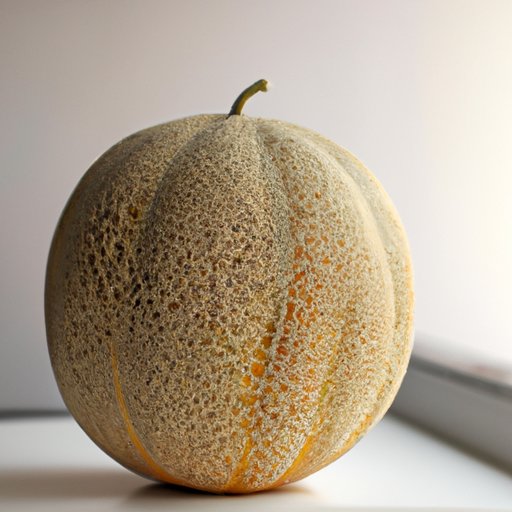
Introduction
Cantaloupes are a delicious and nutritious fruit that can be enjoyed in many ways. However, selecting the best cantaloupe is not always easy, as they often look and feel the same. In this article, we will explore how to choose ripe cantaloupes, the differences between ripe and unripe cantaloupes, the benefits of eating cantaloupe, storage practices, and even some fun facts.
How to Pick the Best Cantaloupes
Choosing the best cantaloupe is important, as it guarantees that you get the best taste and health benefits. Here are some tips on how to choose a ripe cantaloupe:
Checking for Firmness and Even Weight: Ripe cantaloupes should feel firm to the touch. They should also have an even weight distribution, indicating that the fruit has developed evenly.
Inspecting the Rind Color and Texture: The rind should be a creamy yellow color, with a rough, netted texture. Avoid cantaloupes with greenish or white spots, as they indicate unripeness.
Smelling the Stem End: Ripe cantaloupes should have a sweet, fruity aroma. If there is no scent, the cantaloupe may not be ripe yet, or it may be overripe.
One common misconception when selecting cantaloupes is to thump them. However, this is not a reliable method, as a ripe cantaloupe can sound the same as an unripe one.
Understanding Ripe and Unripe Cantaloupes
Knowing when a cantaloupe is properly ripened is important, because an unripe cantaloupe will not have the same flavor and texture as a ripe one. Here are some signs of ripeness:
Softness: Ripe cantaloupes should feel slightly soft when pressed on the stem end. However, it shouldn’t feel too soft or mushy, as that may indicate an overripe cantaloupe.
Netted Rind: Ripe cantaloupes have a rough, netted texture on their rind, with a creamy yellow color. If the rind is greenish or white, or there are no netted ridges, the cantaloupe is not ripe yet.
Recipe Ideas for Cantaloupe
Cantaloupe is a versatile ingredient that can be used in many recipes. Here are some simple recipe ideas to try:
Cantaloupe and Prosciutto Salad: This refreshing salad is perfect for a summer meal. Simply toss cubed cantaloupe with slices of prosciutto, arugula, and a drizzle of balsamic vinegar and olive oil.
Cantaloupe and Cucumber Smoothie: This smoothie is a great way to start your day or a post-workout snack. Blend cubed cantaloupe with cucumber, honey, and mint, and add some almond milk if you like it creamier.
Grilled Cantaloupe with Honey and Lime: This simple dessert requires no more than sliced cantaloupe, honey, and lime juice. You can grill the slices for a few minutes on each side to caramelize and enhance the flavor.
Benefits of Eating Cantaloupe
Cantaloupe is not only delicious but also packed with health benefits. Here are some reasons to include cantaloupe in your diet:
High Water Content: Cantaloupe is composed primarily of water, making it a great way to stay hydrated.
Fiber: Cantaloupe is also high in fiber, which can help regulate digestion and lower cholesterol levels.
Vitamins and Minerals: Cantaloupe is a rich source of vitamin A and C, which can boost your immune system, improve eyesight, and promote skin health. It also contains potassium and folate, which are essential for good health.
Storage Practices for Cantaloupes
Proper storage of cantaloupes is crucial to keep them fresh and ripe. Here are some tips:
Room Temperature: Keep cantaloupes at room temperature until they are ripe, which should take 1 to 2 days.
Refrigeration: Once the cantaloupe is ripe, store it in the refrigerator to slow down the ripening process.
Avoid Cut Cantaloupe: To avoid contamination and spoilage, avoid storing cut cantaloupe for too long.
History and Fun Facts About Cantaloupes
Cantaloupes have a long and interesting history, with many fun facts to discover. Here are some facts to impress your friends:
How Cantaloupes Got Their Name: Cantaloupes were named after Cantalupo, a papal summer residence in Italy where they were first cultivated in the 16th century.
Types of Cantaloupes: There are many varieties of cantaloupes, each with unique characteristics. Some popular types include the Ambrosia, Charentais, and Honeydew.
Conclusion
In conclusion, cantaloupes are a delicious and nutritious fruit that can add flavor and health benefits to your diet. By following these tips on how to pick the best cantaloupe, understanding when a cantaloupe is ripe, and incorporating it into your meals, you can enjoy this tasty fruit in all its glory.
Remember to store your cantaloupes properly, try out some recipe ideas, and impress your friends with some fun facts about this fruit.




